A Jeep winch is essential for anyone who loves off-roading.
It’s not just about pulling your vehicle out of a sticky situation—it’s about having the confidence to explore without limits.
In this article, I’ll take you through what a Jeep winch is, why you need one, and how to use it safely and effectively.
What is a Jeep Winch?
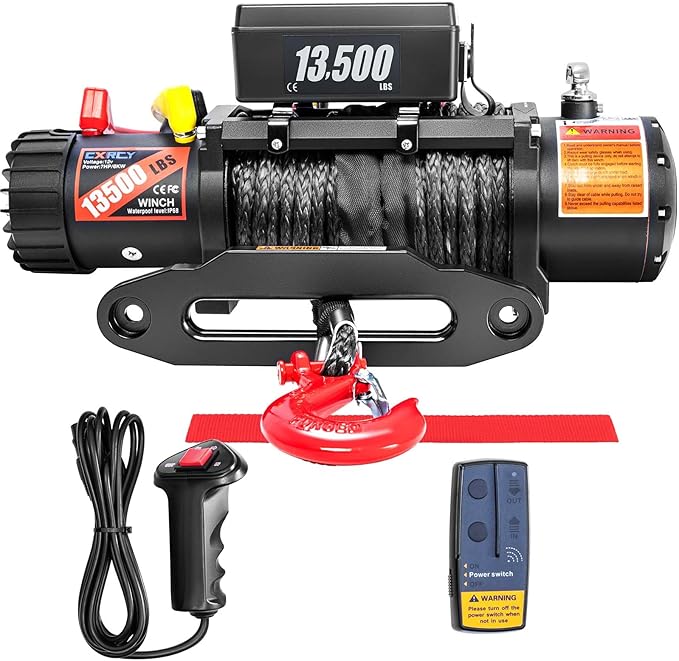
A Jeep winch is a mechanical device designed to pull heavy loads, like your Jeep, out of tough spots. Think of it as a powerful tool that can drag your vehicle out of mud, sand, or snow when it gets stuck.
The winch uses a motor to wind a cable or rope around a drum, creating the force needed to pull heavy objects. It’s especially useful in off-road recovery situations where other methods might fail.
Components of a Jeep Winch
Understanding the parts of a winch helps you use it better and take care of it. The main components include:
- Motor: The powerhouse of the winch, usually powered by your Jeep’s battery.
- Drum: The cylinder around which the cable winds.
- Cable/Rope: Can be steel or synthetic; it’s what pulls your vehicle.
- Fairlead: Guides the cable to prevent it from getting tangled or damaged.
- Hook: Attaches the cable to your Jeep or an anchor point.
Types of Jeep Winches
Electric Winches

Electric winches are the most popular choice among Jeep owners. They are powered by your Jeep’s battery, making them easy to install and use. These winches are versatile and reliable, handling most off-road scenarios with ease.
One of the main advantages of electric winches is their convenience—they don’t require any additional components or modifications to your Jeep’s engine.
However, they do draw power from your battery, so it’s essential to ensure your battery is in good condition, especially if you’re planning to use the winch for extended periods.
Hydraulic Winches
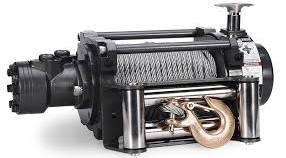
Hydraulic winches, on the other hand, are powered by your Jeep’s power steering pump. This makes them incredibly powerful and capable of handling heavy-duty tasks without overheating, even during continuous use.
Hydraulic winches are often preferred by those who engage in serious off-roading or need a winch for professional purposes. However, they are more complex to install and require a fully operational hydraulic system in your vehicle.
While they don’t drain your battery, they do rely on the engine running, which can be a limitation in some situations.
Common Misconceptions
Many people think that a winch can solve every off-road problem, but that’s not true. A winch is powerful, but it has its limits.
For example, it can’t always overcome a situation where your Jeep is severely bogged down, especially if you don’t anchor it correctly or exceed its weight capacity.
Why You Need a Winch for Your Jeep
Off-Road Recovery
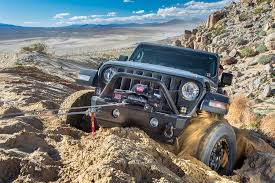
A winch is essential for off-roading because it can pull your Jeep out of tough spots when it gets stuck in deep mud, loose sand, or heavy snow.
Without a winch, you might find yourself stranded or forced to rely on others for help. The winch gives you the ability to self-recover, ensuring that you can get back on the trail quickly and safely.
Vehicle Recovery Assistance
Having a winch means you can assist others in your off-roading group if they get stuck. It’s not just about self-recovery; it’s about being prepared to help your fellow off-roaders.
This makes you a valuable member of any off-roading expedition and can turn a potential disaster into a manageable situation.
Peace of Mind for Adventurous Drivers
Knowing you have a winch on your Jeep provides peace of mind, especially when tackling challenging trails.
It’s like having an insurance policy—something you might not need every time, but when you do, it can save the day. This confidence allows you to explore more challenging terrains, knowing you have a reliable backup if things go wrong.
How to Choose the Right Jeep Winch
When selecting a winch, the most critical factor is its weight capacity. Aim for a winch that can handle at least 1.5 times your Jeep’s gross vehicle weight rating (GVWR).
This ensures the winch has enough power to pull your Jeep out of challenging situations, even if it’s heavily stuck or loaded.
Electric vs. Hydraulic
For most off-roaders, an electric winch is the go-to option. It’s straightforward to install and use, making it perfect for casual to moderate off-roading.
However, if you frequently tackle extreme trails or need a winch for more demanding tasks, a hydraulic winch might be a better choice. Hydraulic winches offer continuous power without the risk of overheating, but they require a more complex installation.
Cable Types: Steel vs. Synthetic
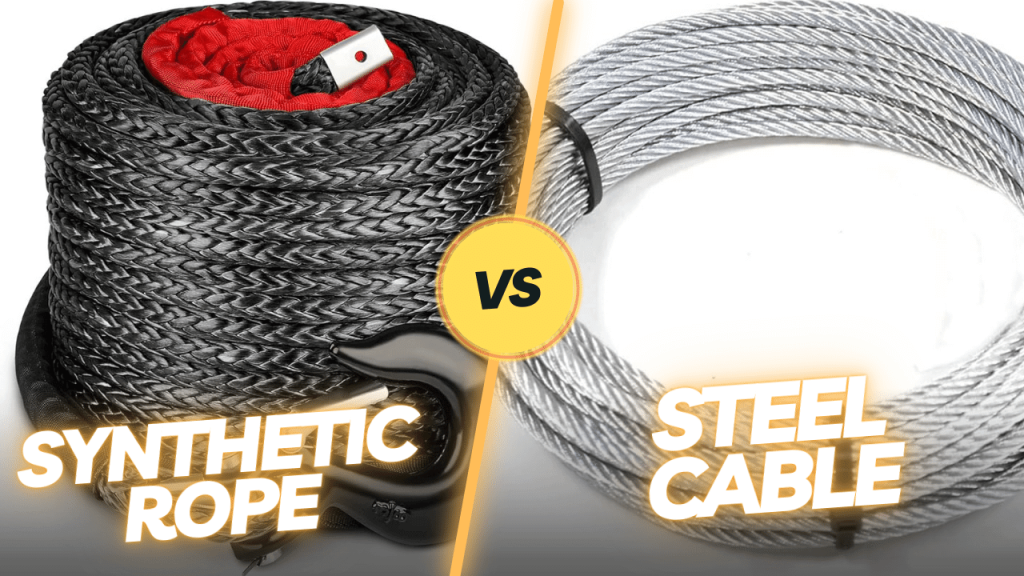
Choosing between steel and synthetic cables depends on your priorities. Steel cables are tough and cost-effective, but they are heavier and can be hazardous if they snap.
Synthetic ropes are lighter and safer to handle, but they can be more expensive and need extra care to prevent damage from UV rays or abrasions.
Additional Features to Consider
Look for useful features that can make winching safer and more convenient. A wireless remote allows you to control the winch from a distance, adding an extra layer of safety.
Automatic braking systems are also beneficial, as they prevent the cable from unwinding accidentally. Finally, ensure the winch can be mounted securely on your Jeep’s bumper or a dedicated winch plate, as proper installation is crucial for safe operation.
Step-by-Step Guide on How to Use a Jeep Winch
Before you start using your winch, a quick inspection is crucial for safety and efficiency. Begin by examining the cable or rope for any signs of wear, such as fraying, kinks, or cuts.
Damaged cables can snap under tension, leading to dangerous situations. Next, check that the hook is securely attached and shows no signs of bending or wear. Lastly, test the motor briefly to ensure it’s functioning correctly.
If the motor sounds off or struggles to run, it might be a sign that something needs attention. A thorough pre-use inspection can prevent accidents and ensure your winch works when you need it most.
Setting Up the Winch
Positioning Your Jeep:

The stability of your Jeep is key when setting up a winch. Ideally, your Jeep should be on stable ground, and if possible, point the vehicle in the direction you plan to winch.
This positioning reduces strain on the winch and makes the process smoother. If the terrain is uneven, take extra care to ensure the vehicle is as level as possible to avoid shifting during winching.
Anchoring Techniques:
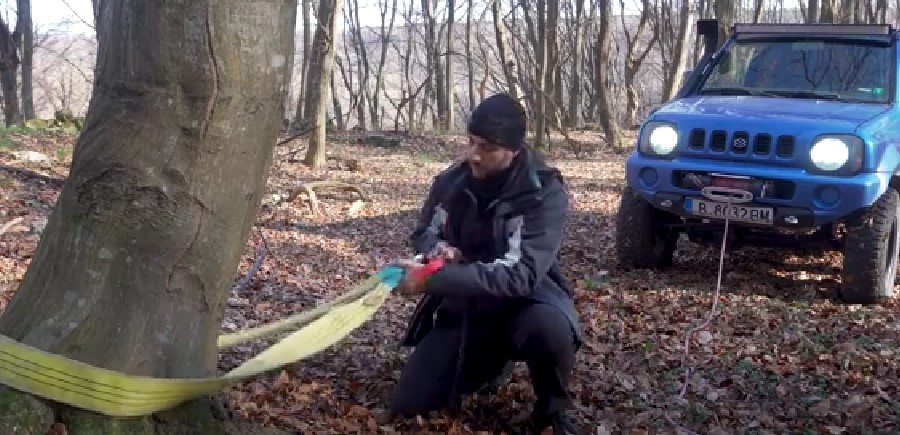
A sturdy anchor point is essential for effective winching. Look for a strong, immovable object like a large tree or a rock. If you’re using a tree, protect it by using a tree saver strap, which spreads the load and prevents damage to the bark.
Secure the winch hook to the strap, ensuring the connection is tight and won’t slip. Proper anchoring is crucial—without a solid anchor, the winch won’t be able to pull effectively, and you risk damaging your equipment or the environment.
Operating the Winch
Engage the Winch:
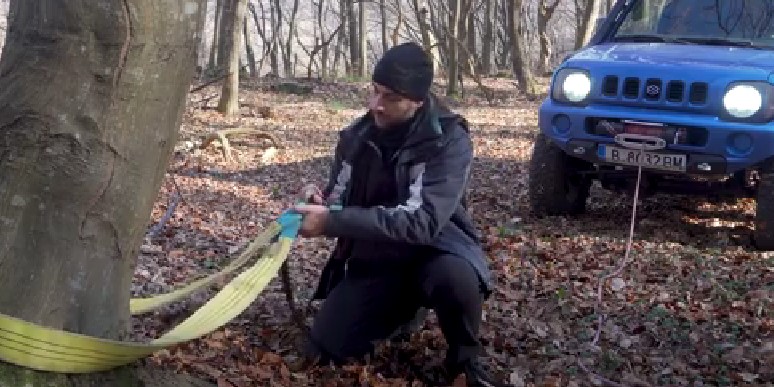
Start by pulling out enough cable to reach the anchor point. Avoid pulling out too much cable, as slack can lead to dangerous whipping if the cable snaps.
Attach the cable securely to the anchor point and ensure everything is set before starting the winch. Once you begin winching, go slowly and steadily, keeping a close eye on the cable.
The goal is to keep the cable taut at all times, which reduces the risk of it slipping or snapping under pressure.
Controlling the Winch:
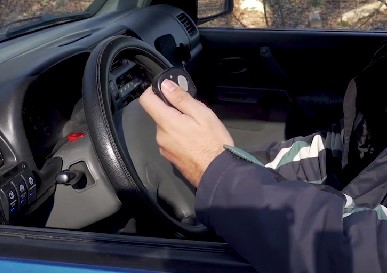
Use the remote control to manage the winch’s speed and direction. Going slow and steady is key to maintaining control and preventing unnecessary strain on the winch.
Rushing the process can lead to mistakes, such as the cable spooling unevenly or the winch overheating. By controlling the winch carefully, you ensure a safer, more efficient recovery.
Safety Precautions
When using a winch, safety is the top priority. Never stand close to a taut winch cable because if it snaps, it can recoil with tremendous force, posing a serious injury risk.
Always wear gloves while handling the cable to protect your hands from any sharp edges or frayed wires. Additionally, placing a winch damper or a heavy blanket over the cable can help reduce the impact if it breaks, minimizing the risk of injury.
Post-Use Maintenance
Once you’ve finished using your winch, take a few moments to inspect the cable for any damage, such as fraying or kinks. If you’re using a synthetic rope, it’s important to clean off any dirt or mud and let it dry completely.
This prevents mold and keeps the rope in good condition for future use. Regular maintenance ensures that your winch remains reliable and safe to use when you need it most.
Common Mistakes to Avoid When Using a Jeep Winch
Overloading the Winch
One of the most common mistakes is overloading the winch beyond its weight capacity. This can cause the motor to overheat and the cable to snap, which is dangerous and can lead to serious injuries or damage to your Jeep.
Always know your winch’s weight limit and stay within it to ensure safe operation.
Improper Cable Handling
Another mistake is allowing the cable to spool unevenly on the drum. This can create tangles and damage the cable, reducing its strength and reliability.
It’s also important to avoid running the cable over sharp edges, which can fray and weaken it over time.
Neglecting Safety Gear
Many people overlook the importance of using safety gear while winching. Always wear gloves to protect your hands, and use a winch damper to minimize the risk of injury if the cable snaps.
Proper safety gear is essential to keep the winching process safe for everyone involved.
Advanced Tips for Effective Winching
Using a Snatch Block
A snatch block is a pulley that can double the pulling power of your winch. It’s useful when you need extra force or want to redirect the pull angle.
Winching on Inclines
When winching on an incline, always try to winch uphill if possible. Winching downhill can be dangerous as gravity adds to the strain on the winch and cable.
Team Winching
Sometimes, you might need to coordinate with other vehicles to get out of a difficult spot. This requires good communication and understanding of each vehicle’s role in the recovery process.
Conclusion
Jeep winches are powerful tools that can make off-roading safer and more enjoyable. By understanding how to choose the right winch, how to use it safely, and how to avoid common mistakes, you can explore with confidence.
Remember, a winch is more than just a piece of equipment—it’s a lifeline when the trail gets tough.

